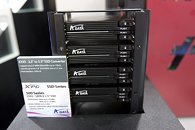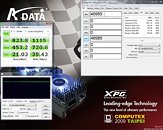Friday, June 5th 2009
A-DATA Presents the Killer Speed of 1TB SSD with XPG 2.5inch to 3.5inch SSD Converter
A-DATA Technology Co., Ltd., a worldwide leading manufacturer in high-performance DRAM modules and Flash application products, presenting the killer speed of eight A-DATA S592 SSDs with XPG 3.5" converter configure in RAID 0 at Computex Taipei 2009. With the utilization of XPG 3.5" converter, the capacity can reach up to 1TB to perform 825 MB/s read and 1,115 MB/s write transfer rate.
The eight A-DATA S592 SSDs adopting the latest XPG EX93 3.5" SSD converter, equipped with safety lock mechanism that can easily secure the SSD/hard drive in 3.5"drive bay without purchasing any accessories, to keeps the valuable data operate in a safety environment. This functional and worthful XPG EX93 3.5" SSD converter is the best choice for those PC user and enthusiasts.
The eight A-DATA S592 SSDs adopting the latest XPG EX93 3.5" SSD converter, equipped with safety lock mechanism that can easily secure the SSD/hard drive in 3.5"drive bay without purchasing any accessories, to keeps the valuable data operate in a safety environment. This functional and worthful XPG EX93 3.5" SSD converter is the best choice for those PC user and enthusiasts.



36 Comments on A-DATA Presents the Killer Speed of 1TB SSD with XPG 2.5inch to 3.5inch SSD Converter
A two-way RAID 0 array is far more likely to fail, crash, die and never be heard from again than a single drive. It's extremely unsafe if you're worried about your data.
As it ramps up to four and eight-way arrays, the chances of it failing magnify severely. I, myself, have five 1TB drives but have never been close to risky enough to try a four-way.
Or, at least that's how I see it.
I'm surprised it held the whole show.
But there's really nothing impressive about this, if you think about it. It's just an eight-way RAID 0 array. You'd get to the same speeds using HDD's as well.. maybe higher since SSD's used to be considered much slower than HDD's in bandwidth.
Do I have to sell my house in order to get one of those???:twitch:
maybe pci-e for these drives?
When you say wear and tear on the RW heads. What do you mean. The heads never touch the plater and the voice coil will last virtually forever.
With SSDs, it's many times more rare for an entire drive to fail. Rather small portions will become unusable through standard use, but the controller chip takes care of that for you, and you keep your data.
And considering that the primary downside to SSDs is drive wearing, spreading your use evenly over 8 drives will actually increase your drive life.
A new defective drive is not unheard of, and a drive failing is not, but to have such terrible luck with numbers of drives leaves one common denominator. You.
I ran RAID 0 for four years, and still have them running, and not a single dead drive yet. Soon I might have one dead, after five years of service.........so if that were in a single drive machine, it would still be dead.
If you buy two hard drives, their lifespan is the same, RAID or not. RAID 0 merely runs the risk that ONE dead drive takes out ALL the data, instead of one dead drive taking out half the data. It doesnt increase the chance of either drive failing.